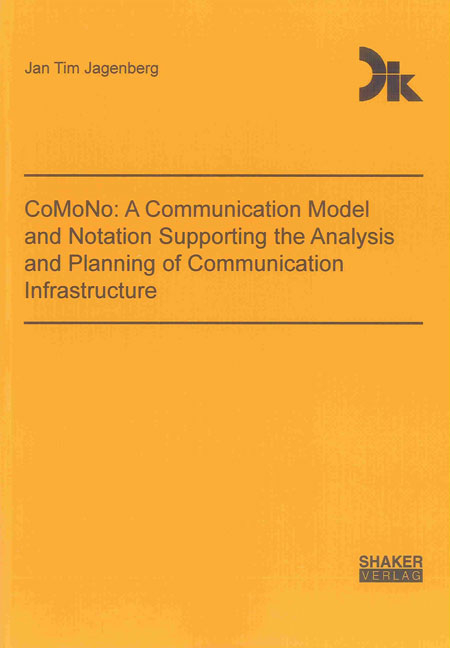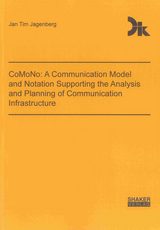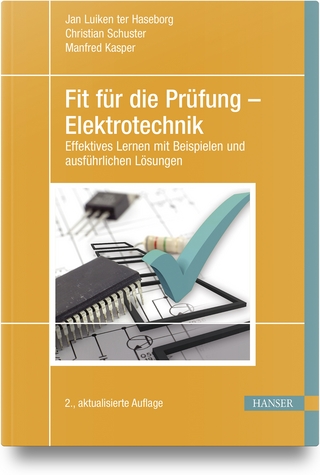CoMoNo: A Communication Model and Notation Supporting the Analysis and Planning of Communication Infrastructure
Seiten
- Keine Verlagsinformationen verfügbar
- Artikel merken
The amount of exchanged information and the choice of possible communication media in engineering increased because of the rise of computer mediated communication and web 2.0 technologies in the recent decades. While many people have adopted a broad range of new communication tools in their personal life, the application of these technologies in enterprise environments is lagging behind. Preceding this development, scholars from various domains started to look at the phenomenon communication from a scientific perspective. In 1928, Hartley developed early mathematical models for a quantitative measure of information. Critical Mass Theory analysed the usage patterns involved in the adoption of interactive media while Media Rich Theory, Media Synchronicity Theory, Task-Technology-Fit Theory, and Enterprise 2.0 study the selection of appropriate media.
Product development approaches like simultaneous engineering, concurrent design, and the management of trust between cooperation partners enable more complex processes. The resulting lower depth of in-house development in turn leads to an increase in communication intensity and complexity. This increasing elaborateness of interactions in businesses led to the development of new business process modelling approaches. Standards like the Business Process Model and Notation (BPMN) enable automated evaluation of the interactively created models. Although BPMN includes models and diagrams focussing on communication processes, they only capture very basic information.
Because of the increasing intensity and complexity of communication in product development, it is necessary to improve the way communication processes and the related infrastructure can be analysed and planned. This dissertation argues that neither media selection theories nor business process modelling alone can offer the benefits an integrated approach can deliver. For a comprehensive analysis of communication processes and the related communication infrastructure, aspects from both fields need to be amalgamated.
The concept presented here defines a Communication Model and Notation (CoMoNo) with extended communication characteristics derived from Media Richness Theory, Media Synchronicity Theory, Task-Technology Fit Theory, and the Enterprise 2.0 approach. Based on the extended model and notation, the concept provides methods for the analysis of communication processes and the planned introduction of appropriate communication media.
A prototypical implementation of the CoMoNo concept was applied to a case study at the Collaborative Research Center 666 – Integral Sheet Metal Design with Higher Order Bifurcations – Development, Production, Evaluation (CRC 666). In a series of interviews, the communication processes of the CRC666 were captured in order to support the evaluation of the proposed model, notation, and methods. 16 of 18 interviewees judged the model and notation as helpful during the interview. 17 considered the notation as easy to understand. According to the analysis based on the gathered data, the CRC666 has a generally well-adapted communication infrastructure, which could benefit from a desktop video-conferencing solution.
As an outlook, the identified remaining discrepancies between communication requirements and existing communication media could be used to drive the development of new media.
Product development approaches like simultaneous engineering, concurrent design, and the management of trust between cooperation partners enable more complex processes. The resulting lower depth of in-house development in turn leads to an increase in communication intensity and complexity. This increasing elaborateness of interactions in businesses led to the development of new business process modelling approaches. Standards like the Business Process Model and Notation (BPMN) enable automated evaluation of the interactively created models. Although BPMN includes models and diagrams focussing on communication processes, they only capture very basic information.
Because of the increasing intensity and complexity of communication in product development, it is necessary to improve the way communication processes and the related infrastructure can be analysed and planned. This dissertation argues that neither media selection theories nor business process modelling alone can offer the benefits an integrated approach can deliver. For a comprehensive analysis of communication processes and the related communication infrastructure, aspects from both fields need to be amalgamated.
The concept presented here defines a Communication Model and Notation (CoMoNo) with extended communication characteristics derived from Media Richness Theory, Media Synchronicity Theory, Task-Technology Fit Theory, and the Enterprise 2.0 approach. Based on the extended model and notation, the concept provides methods for the analysis of communication processes and the planned introduction of appropriate communication media.
A prototypical implementation of the CoMoNo concept was applied to a case study at the Collaborative Research Center 666 – Integral Sheet Metal Design with Higher Order Bifurcations – Development, Production, Evaluation (CRC 666). In a series of interviews, the communication processes of the CRC666 were captured in order to support the evaluation of the proposed model, notation, and methods. 16 of 18 interviewees judged the model and notation as helpful during the interview. 17 considered the notation as easy to understand. According to the analysis based on the gathered data, the CRC666 has a generally well-adapted communication infrastructure, which could benefit from a desktop video-conferencing solution.
As an outlook, the identified remaining discrepancies between communication requirements and existing communication media could be used to drive the development of new media.
| Erscheint lt. Verlag | 31.3.2014 |
|---|---|
| Reihe/Serie | Forschungsberichte aus dem Fachgebiet Datenverarbeitung in der Konstruktion ; 46 |
| Sprache | englisch |
| Maße | 148 x 210 mm |
| Gewicht | 383 g |
| Einbandart | Paperback |
| Themenwelt | Technik ► Elektrotechnik / Energietechnik |
| Schlagworte | communication infrastructure • Communication Media • Communication Requirements • Communication theory • Media Richness Theory |
| ISBN-10 | 3-8440-2699-1 / 3844026991 |
| ISBN-13 | 978-3-8440-2699-3 / 9783844026993 |
| Zustand | Neuware |
| Haben Sie eine Frage zum Produkt? |
Mehr entdecken
aus dem Bereich
aus dem Bereich




